The Fall of the Ottomans: The Great War in the Middle East, 1914-1920
£11.40£12.30 (-7%)
*FULLY UPDATED WITH A NEW FOREWORD*
THE SUNDAY TIMES TOP TEN BESTSELLER
WINNER OF THE BRITISH ARMY MILITARY BOOK OF THE YEAR 2016
‘Truly essential’ Simon Sebag Montefiore
The final destruction of the Ottoman Empire – one of the great epics of the First World War, from bestselling historian Eugene Rogan
For some four centuries the Ottoman Empire had been one of the most powerful states in Europe as well as ruler of the Middle East. By 1914 it had been drastically weakened and circled by numerous predators waiting to finish it off. Following the Ottoman decision to join the First World War on the side of the Central Powers the British, French and Russians hatched a plan to finish the Ottomans off: an ambitious and unprecedented invasion of Gallipoli…
Eugene Rogan’s remarkable book recreates one of the most important but poorly understood fronts of the First World War. Despite fighting back with great skill and ferocity against the Allied onslaught and humiliating the British both at Gallipoli and in Mesopotamia (Iraq), the Ottomans were ultimately defeated, clearing the way for the making, for better or worse, of a new Middle East which has endured to the present.
Read more
Additional information
| Publisher | Penguin (28 July 2022) |
|---|---|
| Language | English |
| Paperback | 528 pages |
| ISBN-10 | 0141999071 |
| ISBN-13 | 978-0141999074 |
| Dimensions | 12.9 x 2.2 x 19.8 cm |

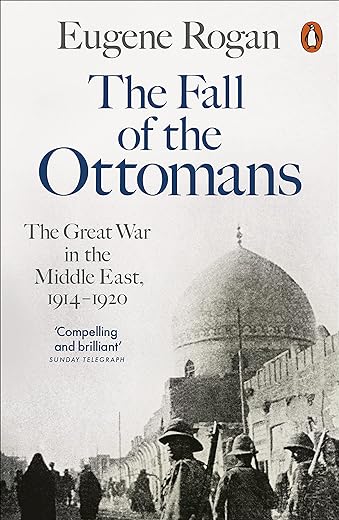
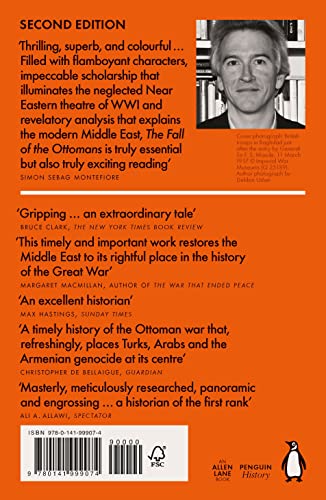
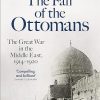

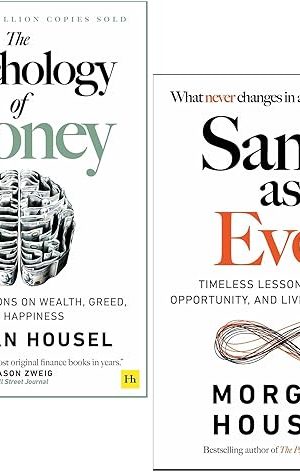


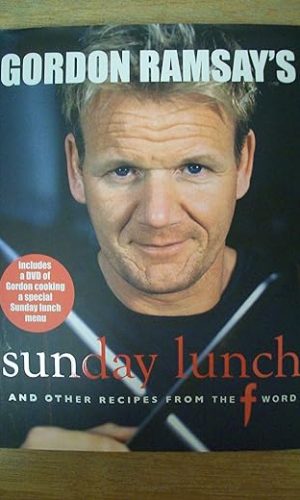



by Athan
There’s a ton of information and loads of opinion in this beautifully written book, but not terribly much cohesion when it comes to the telling of the story itself. Rather, what we have here is a collation of twelve very separate chapters about the six theaters of war that transformed the Great War into WWI: the Caucasian front, the European front (chiefly the Dardenelles), the North African front, the Arab Peninsula, Mesopotamia and what we call today the Middle East. You also get a chapter about the Armenian Genocide.
On the plus side, each chapter stands on its own and can be read separately. On the minus side, stuff gets repeated unnecessarily and you’re often left asking yourself questions along the lines of “this al Askari fellow who’s leading the Arabs against the Ottomans, is he the same guy who was fighting the British earlier in the book in North Africa?” A bit more of an effort could have gone into turning this book into a narrative.
No idea what some of the reviewers are talking about here, the angle is 110% British. It’s not a whitewash, it’s not an attempt to make the British look good, but it’s told by a Brit to other Brits and you’re invited to listen in if you care. For all the personal accounts included, it is most definitely NOT a history of WWI from the Ottoman perspective. That said, with the exception of two and a half fronts (the Caucasian front, the Hijaz and Libya) this is the story of a war between the British and Ottoman Empires, so the British angle is far from inappropriate.
No attempt is made to glorify war. The author admires many of the protagonists and does a very good job of giving their background and explaining their motivations. He does an even better job of conveying the horrors of trench warfare, the divided loyalties of the Ottoman subjects and the plight of the civilians who played host to the two warring empires. Apart from the harrowing descriptions of what it was like to be in the trenches and what it was like to be an Armenian or a POW marched to one’s death, the heart-rending story of the civilians caught in the crossfire in Kut also stands out. The annihilation of Gaza some 100 years ago is quite poignant too.
What I most liked about the book is that the author says it how he sees it. No wishy-washy stuff here. In no particular order, here’s a selection of views:
• Churchill is poorly served by history. Yes, he ordered the original naval attack on the Dardanelles, but the Gallipoli disaster is pretty much down to one man, Kitchener.
• The time honored British technique of naming places with reference to ancient history is outlined, with the example of Cresiphon given, near Baghdad. The author does not mince words about the motivations: it is to take the focus away from the Muslim religion that tied together the subjects of the Empire and toward the ancient history that often divided them. (The author keeps quiet when it comes to the word Palestine, on the other hand)
• Sykes Picot, the Balfour Declaration and the promises made to the Hashemites and the Iraqis were shameful, alright, but that’s easy to say after the fact. In practice, they all amounted to the same thing: in order to beat the Germans and the Ottomans, the British repeatedly promised the same piece of land to multiple sets of people; after the war was over they did what they could to accommodate them all as best they could. (Yes, probably a bit too convenient an explanation, but a brave view nonetheless)
• Laurence of Arabia was a self-promoting buffoon with a good Oxford accent, a solid command of Arabic and a knack for turning up at the right place at the right time, rather than a pivotal character; similarly, if the spoils of war are due to those who have spilt the most blood, the Arabs he occasionally escorted do not truly deserve to feel cheated out of their entitlements.
• The Armenians were clearly targeted for death, they were not merely marched out of their homeland; but their extermination has to be seen under the light of an empire that was facing dismemberment at best and annihilation at worst. While this does not excuse genocide, it provides insight as to what motivated the death marches. The author does not quite say “it was war,” but he comes close.
• The Kurds are invariably depicted as bloodthirsty bandits and looters who did the dirtywork of the Ottomans.
• When they are not singled out as undisciplined looters, the Bedouin tribes are depicted as fickle allies to the Arabs, the Ottomans or the British. This judgement I personally could not square with the understanding the author shows for the very similar behavior of other locals who had no choice other than to bow to the latest conqueror of their territory.
• Indians and Anzacs are a supporting act. The author only ever goes into any detail about them to quote letters they are sending home from the front or to recount Kiwi rowdiness.
While I don’t necessarily buy all these views, and even though they are all rather Anglo-centric, I have to say they are probably what I’ll be left with after having read “The Fall of the Ottomans.”
Overall, this book has kept me excellent company for the last ten days. My recommendation would be “read it, but take notes along the way.”
by docread
Having enjoyed the classic account of David Fromkin ” The peace to end all peace” which covered the events leading to the dismemberment of the Ottoman Empire I was a little disappointed by Rogan’s book. It certainly gives a good account of the various military engagements and the ” Armenian genocide” is well covered with the benefit of new documents coming to light.He is also good at engaging the voices of common diarists from both sides to enrich our historical perspective.But I felt he rushed a bit through the end namely the Syrian campaign and most importantly the aftermath of the war with the rise of the Kemalists trying to salvage the core of the empire, the abolition of the Caliphate , the military victories against the Greek invaders to consolidate the Turkish ethnic homogeneity with new frontiers and the sweeping republican constitutional reforms sounding the death knell of the Ottoman Empire.These were barely mentioned yet they shed more light on the demise of the Empire than the military defeats of WW1.
The author often skimmed over what drove the political decisions which were crucial to the unfolding of the future events in particular the contradictions and vacillations of the British imperial mind reflected through the irreconcilable triad of Sykes- Picot agreement, the Balfour declaration and the MacMahon- Hussain correspondence. In that respect the Fromkin account is far more detailed as he covers both the political and the military aspects and expands on the role of various protagonists . I can appreciate the author’s dilemma had he decided to delve into detailed political and diplomatic history ,it would have meant doubling up the size of the book.
As a good introduction to the military events of the first WW and the Armenian genocide the book fulfils it’s aims but it will disappoint those seeking to understand better the roots of the Arab Turkish antagonism , the reasons why Britain’s policies were so inconsistent and at times contradictory for instance why did they shift their political alliance from the Hashemites to Ibn Saud, the role of the French and the Russians in influencing such policies and the political leverage of the Zionist activists.This is why David Fromkin’s classic work and more recent accounts like ” A line in the sand” are more enlightening reads.
by S. Munir
This book was recommended to me by a friend who said it really helped him understand the historical background to a lot of today’s politics. He also said the writing was such that one just wanted to keep turning the pages to read on.
Having read this book, I agree with him on both points. I love reading and watching history related material. This is an exceptional book and I learnt so much on a topic I thought I already knew quite a lot about. This book has really changed a lot of my previous (incorrect) understandings of what caused World War 1 and the significance of the Eastern Front of the Great War.
I also learnt more about the Armenian genocide than I had ever known.
The book contains moving anecdotes of sparks of humane behaviour between soldiers fighting each other in trench warfare that is surprising to read and not the kind of stuff normally covered in standard histories.
The tempo of the book and stle of writing is like if a really exciting thriller. I kept wanting to just keep reading on and on.
Importantly, the book covers both perspectives of Allied Poerws and Central Powers. Unbiased account.
This book is clearly an example of history telling at its very best. I highly recoomend this book.